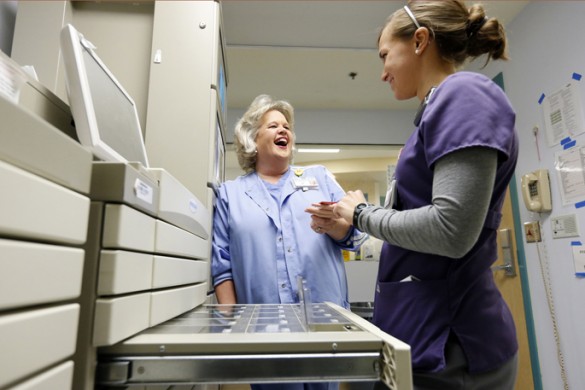
A new unit nursing leadership structure, rolling out first at the Monroe Carell Jr. Children’s Hospital at Vanderbilt, gives bedside nurses more support from their leaders.
“Our current leadership structure has been in place for at least 15 years, but we recognized that it does not allow managers to be true transformational leaders,” said Marilyn Dubree, MSN, R.N., executive chief nursing officer.
“We’re consistently hearing in community surveys and annual evaluations that staff feel that their leader doesn’t know them or have a good relationship with them, while our leaders are saying they love working out on the units but are buried in administrative duties. This change creates a structure that ensures the success of our leaders and the support of our nurses.”
The new structure emphasizes leadership and professional development. It brings leaders closer to the clinical work environment with the goals to improve staff development, the evaluation process, throughput and quality.
Previously, each unit was structured with a manager and assistant managers, who were responsible for leading as many as 120 staff. There was a charge nurse on each shift to manage patient flow and staff assignments.
Now, each unit will still have a manager and will add a business coordinator. The assistant manager and charge nurse roles have been eliminated and a new clinical staff leader (CSL) role has been created in their place.
On average, a clinical staff leader heads a cohort of 20 staff nurses. Each week, they spend two 12-hour shifts working on the unit, and two 8-hour shifts on administrative support and developing and coaching their staff.
“The rationale and goal of this is to better support the bedside caregiver. That’s the bottom line,” said Susan Hernandez, BSN, MBA, R.N., Children’s Hospital chief nursing officer.
“We consistently hear that nurses do not feel their evaluations are valuable because their manager doesn’t know their day-to-day practice. This new structure lets leaders work alongside the nurses, see where they are now, and work together in their growth and development.”

Valerie Herndon, R.N., BSN, is now a CSL on the 6A hematology/oncology unit. With 21 years of nursing experience at Vanderbilt, including 10 as an assistant manager, Herndon admits the new leadership structure required some adjustment.
“At first I was saddened and shocked that my role was being eliminated. I was grieving the loss of a position I had been in forever, but now I see the positive changes and the advantages to the CSL role,” she said.
Instead of juggling the scheduling, evaluations, hiring and oversight of approximately 100 staff, Herndon now focuses on just 20.
“Now I’m more available to my team members and I have more time to focus on them. I feel like we have a closer bond and I hope they feel more valued. In a short time I’ve already seen that, especially on the night shift,” she said.
In addition to the benefits for nursing staff, Kathryn Beard, R.N., on 8C acute care unit, sees improvements for patients and families.
“With a larger leadership team there are more people who are able to check on families,” Beard said. “I was excited about the change. I think the idea behind it — being able to see the leadership team more and work more closely with them — is a positive change.”
When the new clinical staff leader and business coordinator positions were opened, all assistant managers and charge nurses were given the opportunity to apply and guaranteed a staff nurse position, so no jobs were lost due to the change.
The new structure was implemented in October in Acute Care, the Neonatal Intensive Care Unit, the Newborn Nursery and Hematology/Oncology. Other areas in Children’s Hospital will be considered for the leadership model change this winter.
To prepare for the change, clinical staff leaders go through coaching sessions to learn how to apply leadership lessons to real-life situations.
Vanderbilt University Hospital is working with leadership to pilot implementation of the model in the Adult Emergency Department.












